CXCR2 mediates the recruitment of endothelial progenitor cells during allergic airways remodeling
- PMID: 19785013
- PMCID: PMC3385349
- DOI: 10.1002/stem.222
CXCR2 mediates the recruitment of endothelial progenitor cells during allergic airways remodeling
Abstract
Airway remodeling is a central feature of asthma and includes the formation of new peribronchial blood vessels, which is termed angiogenesis. In a number of disease models, bone marrow-derived endothelial progenitor cells (EPCs) have been shown to contribute to the angiogenic response. In this study we set out to determine whether EPCs were recruited into the lungs in a model of allergic airways disease and to identify the factors regulating EPC trafficking in this model. We observed a significant increase in the number of peribronchial blood vessels at day 24, during the acute inflammatory phase of the model. This angiogenic response was associated with an increase in the quantity of EPCs recoverable from the lung. These EPCs formed colonies after 21 days in culture and were shown to express CD31, von Willebrand factor, and vascular endothelial growth factor (VEGF) receptor 2, but were negative for CD45 and CD14. The influx in EPCs was associated with a significant increase in the proangiogenic factors VEGF-A and the CXCR2 ligands, CXCL1 and CXCL2. However, we show directly that, while the CXCL1 and CXCL2 chemokines can recruit EPCs into the lungs of allergen-sensitized mice, VEGF-A was ineffective in this respect. Further, the blockade of CXCR2 significantly reduced EPC numbers in the lungs after allergen exposure and led to a decrease in the numbers of peribronchial blood vessels after allergen challenge with no effect on inflammation. The data presented here provide in vivo evidence that CXCR2 is critical for both EPC recruitment and the angiogenic response in this model of allergic inflammation of the airways.
Figures

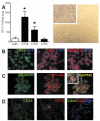
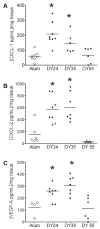
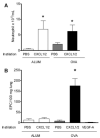
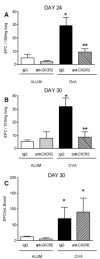
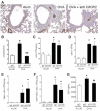
Similar articles
-
Lung homing of endothelial progenitor cells in humans with asthma after allergen challenge.Am J Respir Crit Care Med. 2011 Oct 1;184(7):771-8. doi: 10.1164/rccm.201102-0272OC. Am J Respir Crit Care Med. 2011. PMID: 21719753
-
Th1- and Th2-dependent endothelial progenitor cell recruitment and angiogenic switch in asthma.J Immunol. 2007 May 15;178(10):6482-94. doi: 10.4049/jimmunol.178.10.6482. J Immunol. 2007. PMID: 17475878
-
Allergen-induced, eotaxin-rich, proangiogenic bone marrow progenitors: a blood-borne cellular envoy for lung eosinophilia.J Allergy Clin Immunol. 2010 Apr;125(4):918-25. doi: 10.1016/j.jaci.2010.01.017. Epub 2010 Mar 15. J Allergy Clin Immunol. 2010. PMID: 20227754 Free PMC article.
-
Endothelial progenitor cells as a new agent contributing to vascular repair.Arch Immunol Ther Exp (Warsz). 2007 Jul-Aug;55(4):247-59. doi: 10.1007/s00005-007-0027-5. Epub 2007 Jul 23. Arch Immunol Ther Exp (Warsz). 2007. PMID: 17659378 Review.
-
Endothelial progenitor cells in angiogenesis.Sheng Li Xue Bao. 2005 Feb 25;57(1):1-6. Sheng Li Xue Bao. 2005. PMID: 15719128 Review.
Cited by
-
Role of chemokines in the pathogenesis of acute lung injury.Am J Respir Cell Mol Biol. 2012 May;46(5):566-72. doi: 10.1165/rcmb.2011-0392TR. Epub 2012 Feb 9. Am J Respir Cell Mol Biol. 2012. PMID: 22323365 Free PMC article. Review.
-
The Potential Importance of CXCL1 in the Physiological State and in Noncancer Diseases of the Cardiovascular System, Respiratory System and Skin.Int J Mol Sci. 2022 Dec 22;24(1):205. doi: 10.3390/ijms24010205. Int J Mol Sci. 2022. PMID: 36613652 Free PMC article. Review.
-
Lung macrophages contribute to house dust mite driven airway remodeling via HIF-1α.PLoS One. 2013 Jul 23;8(7):e69246. doi: 10.1371/journal.pone.0069246. Print 2013. PLoS One. 2013. PMID: 23935964 Free PMC article.
-
The First Type III Domain of Fibronectin is Associated with the Expression of Cytokines within the Lung Tumor Microenvironment.J Cancer. 2011;2:478-83. doi: 10.7150/jca.2.478. Epub 2011 Sep 27. J Cancer. 2011. PMID: 21980322 Free PMC article.
-
Effects of cigarette smoke extract on bronchial epithelial cells stimulated with Cryptococcus neoformans.Med Microbiol Immunol. 2021 Aug;210(4):221-233. doi: 10.1007/s00430-021-00715-4. Epub 2021 Jul 6. Med Microbiol Immunol. 2021. PMID: 34228244
References
-
- Zisch AH. Tissue engineering of angiogenesis with autologous endothelial progenitor cells. Curr Opin Biotechnol. 2004;15:424–429. - PubMed
-
- Asosingh K, Swaidani S, Aronica M, et al. Th1- and Th2-dependent endothelial progenitor cell recruitment and angiogenic switch in asthma. J Immunol. 2007;178:6482–6494. - PubMed
Publication types
MeSH terms
Substances
Grants and funding
LinkOut - more resources
Full Text Sources
Other Literature Sources
Medical
Research Materials
Miscellaneous

